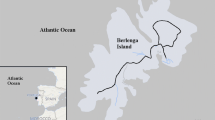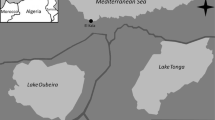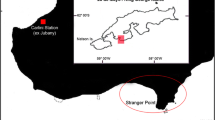Abstract
In recent decades, the Yellow-legged Gull (Larus michahellis) has become a problematic species in many Mediterranean countries, mainly because it interferes with human interests. However, this gull also has a negative impact on several other bird species, many of which are classified as endangered. Two different European Union Action Plans are currently under development with the aim of decreasing the availability of food derived from human activities, such as garbage and fishery discards, which are considered to be the main causes of the superpopulations of this gull. Here, we describe the diet of Yellow-legged Gull chicks, with particular emphasis on establishing the dependence of each population on refuse dumps, in order to forecast changes in gull population dynamics in response to the management decisions being implemented. We sampled four colonies along the Western Mediterranean in Spain: the Medes Islands, the Ebro Delta, the Columbretes Islands, and Mazarrón Island. To elucidate their feeding ecology and to avoid obtaining a discrete estimation from a single sampling, we collected regurgitates from each colony three times throughout the chick-rearing period. Slightly differential feeding habits were observed between chick age classes. Younger chicks in all four colonies tended to be consistently provisioned with smaller prey such as invertebrates. Distinct uses of several foraging habitats among localities were observed. In particular, the use of refuse dumps was common and abundant in two of the colonies: the Medes and Mazarrón Islands. As a consequence of current management strategies, generalized reductions in Yellow-legged Gull populations and increases in the consumption of alternative food resources to those of fishery discards and refuse scraps are expected. Finally, we predict that decreased food availability will force some gulleries to increase predation on endangered species, thereby raising a conservation concern.


Similar content being viewed by others
References
Arcos JM, Oro D, Sol D (2001) Competition between yellow-legged gull Larus cachinnans and Audouin’s gull Larus audouinii associated with commercial fishing vessels: the influence of season and fishing fleet. Mar Biol 139:807–816
Belant JL, Seamans TW, Gabrey SW, Ickes SK (1993) Importance of a landfill to nesting herring gulls. Condor 95:817–830
Bennett PM, Owens IPF (2002) Evolutionary ecology of birds. Oxford University Press, Oxford
Bertellotti M, Yorio P, Blanco G, Giaccardi M (2001) Use of tips by nesting Kelp Gulls at a growing colony in Patagonia. J Field Ornithol 72:338–348
Bosch M, Oro D, Cantos FJ, Zabala M (2000) Short-term effects of culling on the ecology and population dynamics of the yellow-legged gull. J Appl Ecol 37:369–385
Bosch M, Oro D, Ruiz X (1994) Dependence of yellow-legged gulls (Larus cachinnans) on food from human activity in two Western Mediterranean colonies. Avocetta 18:135–139
Cooper RJ, Martinat PJ, Whitmore RC (1990) Dietary similarity among insectivorous birds: influence of taxonomic versus ecological categorization of prey. Stud Avian Biol 13:104–109
Coulson JC, Duncan N, Thomas CS, Monaghan P (1981) An age-related difference in the bill depth of herring gulls Larus argentatus. Ibis 123:499–502
Dolbeer RA, Belant JL, Bernhardt GE (1997) Aerial photography techniques to estimate populations of Laughing Gull nests in Jamaica Bay, New York, 1992–1995. Col Wat 20:8–13
Duffy DC, Jackson S (1986) Diet studies of seabirds: a review of methods. Col Wat 9:1–17
Duhem C, Vidal E, Roche P, Legrand J (2003) Island breeding and continental feeding: how are diet patterns in adult yellow-legged gulls influenced by landfill accessibility and breeding stages? Ecoscience 10:502–508
Duhem C, Vidal E, Roche P, Legrand J (2005) How is the diet of Yellow-legged Gull chicks influenced by parents’ accessibility to landfills? Waterbirds 28:46–52
Furness RW, Ensor K, Hudson AV (1992) The use of fishery waste by gull populations around the British Isles. Ardea 80:105–113
Furness RW, Monaghan P (1987) Seabird ecology. Blackie, Glasgow
García-Morell M, Escribano F (2005) Control de población de la gaviota patiamarilla. Murcia Enclave Ambiental 7:20–27
Garrott RA, White PJ, White CAV (1993) Overabundance: an issue for conservation biologists? Conserv Biol 7:946–949
González-Solís J, Oro D, Pedrocchi V, Jover L, Ruiz X (1997) Bias associated with diet samples in Audouin’s gulls. Condor 99:773–779
Greig SA, Coulson JC, Monaghan P (1983) Age-related differences in foraging success in the herring gull (Larus argentatus). Anim Behav 31:1237–1243
Holm S (1979) A simple sequential rejective multiple test procedure. Scand J Stat 6:65–70
Keylock CJ (2005) Simpson diversity and the Shannon–Wiener index as special cases of a generalized entropy. Oikos 109:203–207
Kilpi M, Öst M (1998) Reduced availability of refuse and breeding output in a herring gull (Larus argentatus) colony. Ann Zool Fenn 35:37–42
La Mesa M, Vacchi M, Zunini Sertorio T (2000) Feeding plasticity of Trematomus newnesi (Pisces, Nototheniidae) in Terra Nova Bay, Ross Sea, in relation to environmental conditions. Polar Biol 23:38–45
Martínez-Abraín A, González-Solís J, Pedrocchi V, Genovart X, Abella JC, Ruiz X, Jiménez J, Oro D (2003) Kleptoparasitism, disturbance and predation of yellow-legged gulls on Audouin’s gulls in three colonies of the western Mediterranean. Sci Mar 67:89–94
Monaghan P, Shedden CD, Ensor K, Fricker CR, Girdwood RWA (1985) Salmonella carriage by herring gulls in the Clyde area of Scotland in relation to their feeding ecology. J Appl Ecol 22:669–680
Mudge GP, Ferns PN (1982) The feeding ecology of five species of gulls (Aves: Larini) in the inner Bristol Channel. J Zool 197:497–510
Oro D (1995) Audouin’s gulls Larus audouinii associate with sub-surface predators in the Mediterranean Sea. J Ornithol 136:465–467
Oro D, De León A, Mínguez E, Furness RW (2005) Estimating predation on breeding European storm-petrels (Hydrobates pelagicus) by yellow-legged gulls (Larus michahellis). J Zool 265:421–429
Oro D, Martínez-Abraín A (2007) Deconstructing myths on large gulls and their impact on threatened sympatric waterbirds. Anim Conserv 10:117–126
Oro D, Martinez-Abrain A, Paracuellos M, Nevado JC, Genovart M (2006) Influence of density dependence on predator-prey seabird interactions at large spatio-temporal scales. Proc R Soc B 273:379–383
Pedrocchi V, Oro D, González-Solís J (1996) Differences between diet of adult and chick Audouin’s gulls Larus audouinii at the Chafarinas Islands, SW Mediterranean. Ornis Fennica 73:124–130
Pielou EC (1967) The use of information theory in the study of the diversity of biological populations. Proc 5th Berkeley Symp Math Star Prob 4:163–177
Pierotti R, Annet CA (1991) Diet choice in the herring gull: constraints imposed by reproductive and ecological factors. Ecology 72:319–328
Pons JM (1992) Effects of changes in the availability of human refuse on breeding parameters in a herring gull Larus argentatus population in Brittany, France. Ardea 80:143–150
Schoener TW (1971) Theory of foraging strategies. Annu Rev Ecol Syst 2:369–404
Seefelt NE, Gillingham J (2006) A comparison of three methods to investigate the diet of breeding double-crested cormorants (Phalacrocorax auritus) in the Beaver Archipelago, northern Lake Michigan. Hydrobiologia 567:57–67
Shannon CE, Weaver W (1949) A mathematical theory of communication. University of Illinois Press
Steele WK, Hockey PAR (1990) Population size, distribution and dispersal of Kelp gulls in the southwestern Cape, South Africa. Ostrich 61:97–106
Swennen C, Van de Meer J (1992) Variation in egg size of Common Eiders. Ardea 80:363–373
Thomas GJ (1972) A review of gull damage and management methods at nature reserves. Biol Conserv 4:117–127
Vidal E, Medail F, Tatoni T (1998) Is the yellow-legged gull a superabundant bird species in the Mediterranean? Impact on fauna and flora, conservation measures and research priorities. Biodivers Conserv 7:1013–1026
Werschkul DF (1979) Nesting mortality and the adaptive significance of early locomotion in the Little Blue Heron. Auk 96:116–130
Zar JH (1996) Biostatistical analysis. Prentice-Hall, London
Acknowledgments
We thank the wildlife authorities of the respective communities for permission to conduct this study. We would like to thank the wardens of the Columbretes Islands, especially R. Belenguer, M. Prados, and V. Tena, for their warm welcome and their invaluable assistance with the fieldwork. We also thank our colleague S. Ferrer for his help in the field and in the laboratory. R.R. was supported by a FPU grant awarded by the Spanish Ministerio de Educación y Ciencia (MEyC), and financial support throughout the study was provided by the project REN2003-07050 Aplicación de biomarcadores a la gestión de una especie problemática (Larus cachinnans). All experiments and protocols performed in this study comply with current European legislation.
Author information
Authors and Affiliations
Corresponding author
Additional information
Communicated by P.H. Becker.
X. Ruiz: deceased on 27 April 2008.
Rights and permissions
About this article
Cite this article
Ramos, R., Ramírez, F., Sanpera, C. et al. Diet of Yellow-legged Gull (Larus michahellis) chicks along the Spanish Western Mediterranean coast: the relevance of refuse dumps. J Ornithol 150, 265–272 (2009). https://doi.org/10.1007/s10336-008-0346-2
Received:
Revised:
Accepted:
Published:
Issue Date:
DOI: https://doi.org/10.1007/s10336-008-0346-2




